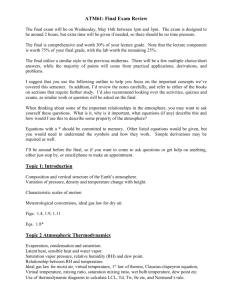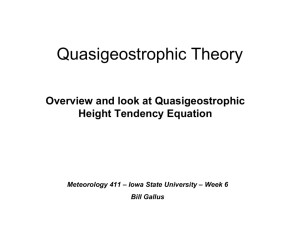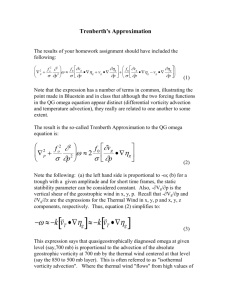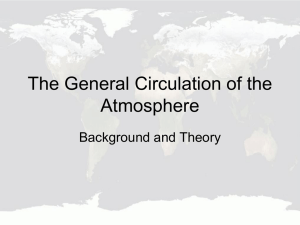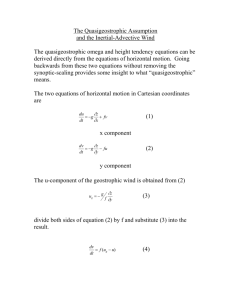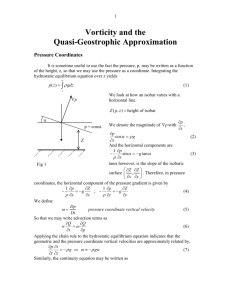simple_balances_synoptic
advertisement
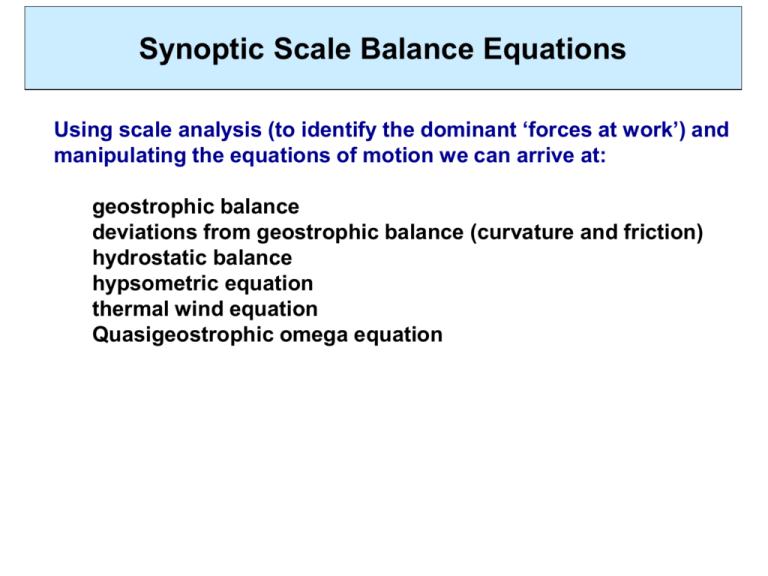
Synoptic Scale Balance Equations Using scale analysis (to identify the dominant ‘forces at work’) and manipulating the equations of motion we can arrive at: geostrophic balance deviations from geostrophic balance (curvature and friction) hydrostatic balance hypsometric equation thermal wind equation Quasigeostrophic omega equation DLA Fig.10.2 The space and time scales of motion for a particular type of system are the characteristic distances and times traveled by air parcels in the system (or by molecules for molecular scales). Example Scale Analysis Horizontal Momentum Equation Synoptic Scale: U ≈ 10 m/s W ≈ 10-2 m/s L ≈ 106 m H ≈ 104 m T = L/U ≈ 105 s R ≈ 107 m fo ≈ 10-4 1/s Po ≈ 1000 hPa 1 Pa = kg/(ms2) ρ ≈ 1 kg/m3 Du Dt -2Wvsin f U2 L foU 10-4 10-3 -2Wvsin f = - +2Ww cos f + uw a - uv tan f a foW UW a U2 a 10-6 10-8 10-5 1 ¶p r ¶x = - 1 ¶p r ¶x DP rL 10-3 geostrophic balance Forces Acting on the Atmosphere – Pressure Gradient Force causes a net force on air, directed toward lower pressure DLA Fig. 7.5 Forces Acting on the Atmosphere Coriolis Force to the right of motion in the NH strength determined by: 1.latitude 2.speed of motion DLA Fig. 7.7A Synoptic Scale Balance Equations Using scale analysis (to identify the dominant ‘forces at work’) and manipulating the equations of motion we can arrive at: geostrophic balance deviations from geostrophic balance (curvature and friction) hydrostatic balance hypsometric equation thermal wind equation Quasigeostrophic omega equation Forces Acting on the Atmosphere Centripetal Force & Gradient Wind Balance force pointing away the center around which an object is turning centripetal acc = centrifugal force (difference beteeen PGF and COR) DLA Fig. 7.13 Geostrophic Approximation: Strengths and Weaknesses – curved flow Winds and Heights at 500 mb Geostrophic Approximation: Strengths and Weaknesses Geostrophic Winds at 500 mb (determined using analyzed Z and geostrophic equations) Geostrophic, Gradient, and Real Winds Winds - Geostrophic Winds = Ageostrophic Winds (What’s Missing From Geostrophy) Vg is too weak Vg is too strong Forces Acting on the Atmosphere Friction DLA Fig. 7.14 DLA Fig. 7.15 Synoptic Scale Balance Equations Using scale analysis (to identify the dominant ‘forces at work’) and manipulating the equations of motion we can arrive at: geostrophic balance deviations from geostrophic balance (curvature and friction) hydrostatic balance hypsometric equation thermal wind equation Quasigeostrophic omega equation Example Scale Analysis Vertical Momentum Equation Synoptic Scale: U ≈ 10 m/s W ≈ 10-2 m/s L ≈ 106 m H ≈ 104 m T = L/U ≈ 105 s R ≈ 107 m fo ≈ 10-4 1/s Po ≈ 1000 hPa 1 Pa = kg/(ms2) ρ ≈ 1 kg/m3 Dw u2 + v 2 1 ¶p - 2Wucosf = - g + Frz Dt R r ¶z UW L 10 -7 f oU U2 R Po rH g nWH -2 10 -3 10 -5 10 10 10 -15 1 ¶p = -g r ¶z hydrostatic balance Hydrostatic Balance air parcel in hydrostatic balance experiences no net force in the vertical DLA Fig. 7.6 Synoptic Scale Balance Equations Using scale analysis (to identify the dominant ‘forces at work’) and manipulating the equations of motion we can arrive at: geostrophic balance deviations from geostrophic balance (curvature and friction) hydrostatic balance hypsometric equation thermal wind equation Quasigeostrophic omega equation Geopotential, Geopotential Height, and the Hyposmetric Equation We arrive at the hypsometric equation by using scale analysis (hydrostatic balance) and by combining the hydrostratic equation and the equation of state Dp Df = -RT p DZ = - Hypsometric Equation RT Dp g p The hypsometric equation: 1. provides a quantitative measure of the geometric distance between 2 pressure surfaces – it is directly proportional to the temperature of the layer 2. Shows that the gravitational potential energy gained when raising a parcel is also proportional to the temperature of the layer We can quantitatively see what we intuitively know: a warm layer will be thicker than a cool layer Synoptic Scale Balance Equations Using scale analysis (to identify the dominant ‘forces at work’) and manipulating the equations of motion we can arrive at: geostrophic balance deviations from geostrophic balance (curvature and friction) hydrostatic balance hypsometric equation thermal wind equation Quasigeostrophic omega equation Thermal Wind - Concepts • Horizontal T gradients horizontal p gradients vertical variations in winds (e.g. geostrophic winds) A non-zero horizontal T gradient leads to vertical wind shear • Thermal wind (VT) describes this vertical wind shear: → not an actual wind → it represents the difference between the geostrophic wind at 2 vertical levels → specifically, VT relates the horizontal T gradient to the vertical wind shear Thermal Wind - Concepts • VT is therefore a useful tool for analyzing the relationship between T, ρ, p and winds ¶Vg ¶z Û ÑH T • VT also provides information about T advection (backing vs. veering) The Thermal Wind Equation • VT is derived by combining the hypsometric equation and the geostrophic equation const DT uT » f Dy const DT ; vT » f Dx • Note similarity to geostrophic wind, except T replaces Φ • VT ‘blows’ parallel to isotherms, with low T on the left Thermal Wind Spatial relationships between horizontal T and thickness gradients, horizontal p gradient, and vertical geostrophic wind gradient. cold warm H, Fig. 3.8 ( ) - (v ) vT = vg top g bot const DT » f Dx DT >0 Dx Þ vT is positive vg increases w/ height Thermal Wind – Climatological Averages ¶ug DT >0 Û <0 Dy ¶z ¶ug DT »0 Û »0 Dy ¶z ¶ug DT <0 Û >0 Dy ¶z North South y ( ) - (u ) uT = ug top g bot const DT »f Dy WH Figure 1.11 Thermal Wind – Extratropical Cyclone we can apply the same logic to the instantaneous picture in an extratropical cylcone N W SE Vertical cross section from Omaha, NE to Charleston, SC. WH Figure 3.19 Synoptic Scale Balance Equations Using scale analysis (to identify the dominant ‘forces at work’) and manipulating the equations of motion we can arrive at: geostrophic balance deviations from geostrophic balance (curvature and friction) hydrostatic balance hypsometric equation thermal wind equation Quasigeostrophic omega equation Term B – Relationship of Upper Level Vorticity to Divergence / Convergence DLA Fig. 8.31 æ ¶u ¶v ö Dz a = - foç + ÷ Dt è ¶x ¶y ø following air parcel motion: - divergence occurs where ζa is decreasing - convergence occurs where ζa is increasing Omega Equation – Derivation (1) (2) (3) ¶z g ¶w = -Vg iÑ z g + f + fo ¶t ¶p ( ) æ ¶f ö ¶ æ ¶f ö - ÷ = -Vg iÑ ç - ÷ + sw ç è ¶p ø ¶t è ¶p ø 1 2 zg = Ñ f fo plug (3) into (1) re-arrange (2) quasigeostrophic vorticity equation quasigeostrophic thermodynamic equation quasigeostrophic relative vorticity can be expressed as the Laplacian of geopotential (4) (5) 1 2 æ ¶f ö ¶w Ñ ç ÷ = -Vg iÑ z g + f + fo fo è ¶t ø ¶p ( ) æ ¶f ö ¶ æ ¶f ö - ç ÷ = -Vg iÑ ç - ÷ + sw è ¶p ø ¶p è ¶t ø Omega Equation – Derivation ¶ delete t derivates by : fo ( 4 ) + Ñ2 ( 5 ) Þ Omega Equation ¶p æ ¶f ö ù ¶ æ 2 fo ö 2 é s ç Ñ + ÷ w = fo éëVg iÑ z g + f ùû + Ñ êVg iÑ ç - ÷ ú è sø ¶p è ¶p ø û ë ( ) the QG Omega Equation is a diagnostic equation used to determine rising and sinking motion based solely on the 3D structure of the geopotential • no wind observations necessary • no info regarding vorticity tendency • no T structure • downside: higher order derivates Omega Equation – Derivation æ ¶f ö ù ¶ æ 2 fo ö 2 é s ç Ñ + ÷ w = fo éëVg iÑ z g + f ùû + Ñ êVg iÑ ç - ÷ ú è sø ¶p è ¶p ø û ë ( A Rising/Sinking A ≅ - sign LHS ≅ - ω + RHS = rising motion - RHS = sinking motion ) B Differential Vorticity Advection + B = + vorticity adv. rising -B = - vorticiy adv. sinking C Thickness Advection + C = warm adv. rising - C = cold adv. sinking Term B – Differential Vorticity Advection ¶ w µ éë -Vg iÑ z g + f ùû ¶z ( PVA ¶z g ¶f >0Û <0 ¶t ¶t 500 mb Height 1000 mb Height PVA ) z g µ Ñ f µ -f 2 ¶z g ¶f \ µ¶t ¶t Above Surface the columnL is cooling there is very little temperature advection above the L center the only way for the layer to cool is via adiabatic cooling (rising) H Fig. 6.11 Term B – Differential Vorticity Advection ¶ w µ éë -Vg iÑ z g + f ùû ¶z ( NVA ¶z g ¶f <0Û >0 ¶t ¶t 500 mb Height 1000 mb Height NVA ) z g µ Ñ f µ -f 2 ¶z g ¶f \ µ¶t ¶t Above Surface H the column is warming there is very little temperature advection above the H center the only way for the layer to warm is via adiabatic warming (sinking) H Fig. 6.11 Term B – Differential Vorticity Advection the ageostrophic circulation (rising/sinking) predicted in the previous slides maintains a hydrostatic T field (T and thickness are proportional) in the presence of differential vorticity advection without the vertical motion, either the vorticity changes at 500 mb could not remain geostrophic or the T changes in the 1000-500 mb layer would not remain hydrostatic Term C – Thickness Advection æ ¶f ö w µ -Vg iÑ ç - ÷ è ¶p ø WAA ¶z g ¶f >0Û <0 ¶t ¶t 500 mb Height 1000 mb Height WAA z g µ Ñ f µ -f 2 ¶z g ¶f \ µ¶t ¶t At the 500 mb Ridge anticyclonic vorticity must increase at the 500 mb ridge, vorticity advection cannot produce additional anticyclonic vorticity divergence is required (rising) H Fig. 6.11 Term C – Thickness Advection æ ¶f ö w µ -Vg iÑ ç - ÷ è ¶p ø CAA ¶z g ¶f <0Û >0 ¶t ¶t 500 mb Height 1000 mb Height CAA z g µ Ñ f µ -f 2 ¶z g ¶f \ µ¶t ¶t At the 500 mb Trough cyclonic vorticity must increase at the 500 mb trough, vorticity advection cannot produce additional cyclonic vorticity convergence is required (sinking) H Fig. 6.11 Term C – Thickness Advection the predicted vertical motion pattern is exactly that required to keep the upper-level vorticity field geostrophic in the presence of height changes caused by the thermal advection
